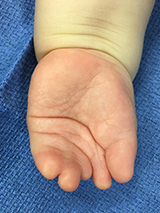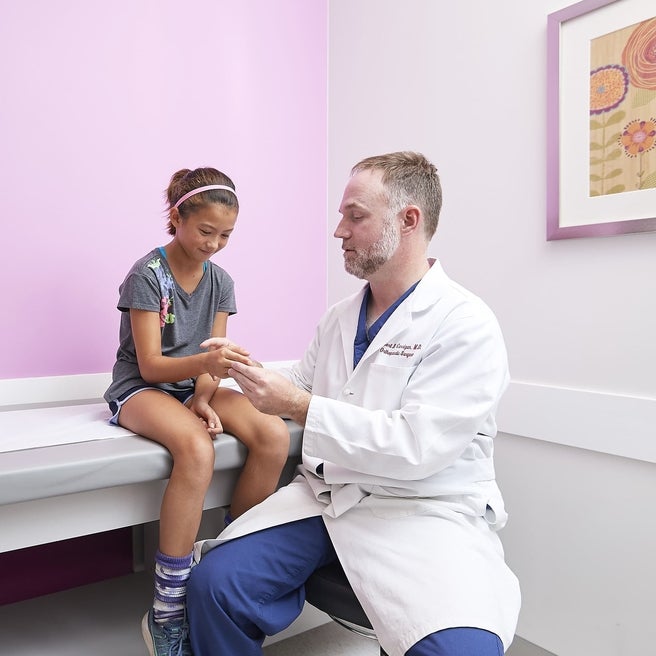What is symbrachydactyly?

Symbrachydactyly is a rare congenital hand condition in which a child is born with abnormally short fingers that may be webbed, misshaped or missing. Usually, only one hand is affected; the other hand appears normal.
Most children with symbrachydactyly have a complete thumb, but in some children the thumb may be short or absent.
Symbrachydactyly is often confused with other hand conditions, but differs in that the underlying structure of the hand is affected — not just the fingers. The hand may not function well, and the bones, muscles, ligaments, and nerves of the hand are also often affected.
About one in 32,000 babies is born with symbrachydactyly, making it one of the more rare congenital hand conditions, but it affects boys and girls equally and generally does not have a genetic cause.
Causes of symbrachydactyly
Researchers say there is little evidence to show symbrachydactyly is caused by a genetic defect or passed from generation to generation. Instead, researchers believe symbrachydactyly is caused by a disruption in prenatal development.
When a baby begins to form in utero, their hands are shaped like mittens. As the baby grows, the hand divides and fingers form. For babies with symbrachydactyly, the fingers — generally on one hand only – don’t fully form. Bones may be smaller than normal or completely absent.
Signs and symptoms of symbrachydactyly

Symptoms of symbrachydactyly are varied, but include:
- Short fingers; bones in the fingers may be smaller than normal or missing entirely
- Small nubs of skin and soft tissue where fingers should be
- Fingers that are webbed or conjoined (syndactyly)
- Finger stiffness and limited use of the hand
- Short bones in the hand (metacarpals)
Testing and diagnosis of symbrachydactyly
Most children with symbrachydactyly are diagnosed at birth when hand and finger differences are apparent. As prenatal imaging has improved, some babies are being diagnosed before birth with hand differences, though testing after birth must be done to confirm the findings.
At Children's Hospital of Philadelphia (CHOP), diagnosing symbrachydactyly begins with a physical examination of your child’s affected hand.
In most cases, clinicians will recommend an X-ray to confirm the diagnosis and learn more about which bones are affected in your child’s hand, and sometimes in the wrist and forearm. X-rays produce images of bones and help doctors identify the underlying structure of the affected limb.
In addition to a physical exam and X-rays, your child may also undergo:
- Magnetic resonance imaging (MRI), which uses a combination of large magnets, radiofrequencies and a computer to produce detailed images of organs, soft tissues, muscles, ligaments and other structures within the body. This test can be especially helpful for child with finger nubs. Your child is exposed to no radiation during an MRI.
- Range of motion tests to determine if the condition is affecting movement and dexterity
Accurate diagnosis helps us determine the best course of treatment for your child.
Treatment for symbrachydactyly
Treatment for symbrachydactyly will depend on the severity of your child’s condition, as well as the age and development of your child. Children born with mild symbrachydactyly may not need any treatment because they are able to do all the things a child does. Children with limited dexterity or severe hand deformities will need active treatment.
Nonsurgical interventions
If your child has shortened fingers and an intact thumb on the affected hand, clinicians may recommend occupational for your child. An occupational therapist will teach your child how to make the best use of their affected hand, sometimes using their typically developing hand to assist with some tasks.
With hand therapy, children with mild symbrachydactyly can learn to perform many everyday activities such as getting dressed, feeding themselves and writing. Occupational therapy may evolve over time to include new age-appropriate tasks as your child grows.
Surgical interventions
Children with more severe forms of symbrachydactyly will require surgery to improve the function or appearance of their hand. At CHOP, fellowship-trained hand surgeons perform a variety of operations to repair congenital anomalies in the hand and arm, increase hand function and motor skills, as well as improve the outward appearance of the affected hand.
Surgery for symbrachydactyly is highly complex and may involve multiple procedures. Surgery often improves your child’s ability to grasp and pinch objects, improving their ability to perform everyday activities. In some cases, the web spaces between the fingers will be reconstructed (deepened). This can require skin grafting. In others cases, bones in the hand may be lengthened or bones from your child’s toes will be transferred to add length to affected fingers. In rare cases, an entire toe can be transferred to the hand.
Safety in surgery
Surgery can dramatically improve the long-term outcomes for your child with symbrachydactyly, but it can also be a stressful experience for you and your child.
At CHOP, we offer a wealth of resources that can help you and your child prepare for surgery. Additionally, we follow many best practices before, during and after surgery to decrease the risk of infection and increase positive outcomes. Our safety protocols have been so successful that many other institutions have adopted them.
To learn more, read how we make safety in surgery a top priority.
Follow-up care after symbrachydactyly treatment
Follow-up care for symbrachydactyly will depend on the treatment needed. If your child is receiving occupational therapy, they will be regularly evaluated to ensure their hand function is improving and determine if surgery is needed.
Most children who had surgery to treat their symbrachydactyly will have a cast or split applied to keep their hand immobilized and promote healing.
If your child had surgery, their affected hand will be likely be immobilized with a cast or splint for several weeks to ensure proper healing. Your child will be examined at at least twice in the first 2 to 3 months post-operatively, and then monitored regularly for at least a few years.
Additional surgeries will be performed as needed. Your child’s doctor will give you specific information about a recovery program for your child and how soon they can return to daily activities.
Outlook
The long-term outlook for children treated for symbrachydactyly is generally good. Children with mild symbrachydactyly generally respond well to occupational therapy, and surgery has been extremely effective for children with more serious cases. While some cosmetic hand differences may remain, most children treated for symbrachydactyly will be able to perform all activities of daily living.
Resources to help
Symbrachydactyly Resources
Hand and Arm Disorders Program Resources
We have compiled resources to help you find answers to your questions and feel confident with the care you are providing your child.
Reviewed by Apurva S. Shah, MD, MBA
